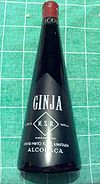
Ginjinha
Encyclopedia
Ginjinha or simply Ginja, is a liqueur
made by infusing
ginja berries, (sour cherry
) (Prunus cerasus austera, the Morello cherry) in alcohol (aguardente is used) and adding sugar together with other ingredients. Ginjinha is served in a shot form with a piece of the fruit in the bottom of the cup. It is a favourite liqueur of many Portuguese and a typical drink in Lisbon
, Alcobaça and Óbidos. Other regions produce ginja with protected designation of origin
, for example the Ginja Serra da Estrela.
 The Ginjinha of the Praça de São Domingos in Lisbon was the first establishment in that city to commercialize the drink that gives its name to it. A Galician friar
The Ginjinha of the Praça de São Domingos in Lisbon was the first establishment in that city to commercialize the drink that gives its name to it. A Galician friar
of the Church of Santo Antonio
, Francisco Espinheira, had the experience of leaving ginja berries in aguardente (the Portuguese brandy), adding sugar, water and cinnamon. The success was immediate and Ginginha became the typical drink of Lisbon. In the 2000s, the business was in the hands of the fifth generation. Currently, "the Ginjinha" is an exporter for the market in the United States. The production of Ginjinha reached over 150 thousand litres per year. In many places of Portugal, especially in the Lisbon and Oeste
regions, there are several producers of this traditional liqueur. In Óbidos, Ginjinha is commonly served in a small edible chocolate cup.
Liqueur
A liqueur is an alcoholic beverage that has been flavored with fruit, herbs, nuts, spices, flowers, or cream and bottled with added sugar. Liqueurs are typically quite sweet; they are usually not aged for long but may have resting periods during their production to allow flavors to marry.The...
made by infusing
Infusion
An infusion is the outcome of steeping plants with desired chemical compounds or flavors in water or oil.-History:The first recorded use of essential oils was in the 10th or 11th century by the Persian polymath Avicenna, possibly in The Canon of Medicine.-Preparation techniques:An infusion is very...
ginja berries, (sour cherry
Sour Cherry
Prunus cerasus, or the sour cherry, is a species of Prunus in the subgenus Cerasus , native to much of Europe and southwest Asia. It is closely related to the wild cherry Prunus cerasus, or the sour cherry, is a species of Prunus in the subgenus Cerasus (cherries), native to much of Europe and...
) (Prunus cerasus austera, the Morello cherry) in alcohol (aguardente is used) and adding sugar together with other ingredients. Ginjinha is served in a shot form with a piece of the fruit in the bottom of the cup. It is a favourite liqueur of many Portuguese and a typical drink in Lisbon
Lisbon
Lisbon is the capital city and largest city of Portugal with a population of 545,245 within its administrative limits on a land area of . The urban area of Lisbon extends beyond the administrative city limits with a population of 3 million on an area of , making it the 9th most populous urban...
, Alcobaça and Óbidos. Other regions produce ginja with protected designation of origin
Protected designation of origin
Protected Geographical Status is a legal framework defined in European Union law to protect the names of regional foods. Protected Designation of Origin , Protected Geographical Indication and Traditional Speciality Guaranteed are distinct regimes of geographical indications within the framework...
, for example the Ginja Serra da Estrela.
History

Friar
A friar is a member of one of the mendicant orders.-Friars and monks:...
of the Church of Santo Antonio
Santo Antônio (disambiguation)
There are parishes that have the name Santo António :-In the Azores:*Santo António , a parish in the municipality of Ponta Delgada...
, Francisco Espinheira, had the experience of leaving ginja berries in aguardente (the Portuguese brandy), adding sugar, water and cinnamon. The success was immediate and Ginginha became the typical drink of Lisbon. In the 2000s, the business was in the hands of the fifth generation. Currently, "the Ginjinha" is an exporter for the market in the United States. The production of Ginjinha reached over 150 thousand litres per year. In many places of Portugal, especially in the Lisbon and Oeste
Oeste
Oeste, is a NUTS 3 sub-region of the NUTS 2 Centro Region of Portugal. The sub-region is coterminous with the Comunidade Intermunicipal do Oeste of the same name...
regions, there are several producers of this traditional liqueur. In Óbidos, Ginjinha is commonly served in a small edible chocolate cup.

